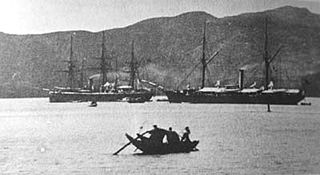 W
WChaoyong was a cruiser built for the Imperial Chinese Navy. She was built by Charles Mitchell & Company in Newcastle Upon Tyne, England, from a design by Sir George Wightwick Rendel which had already been used on the Chilean Navy vessel Arturo Prat. Two ships were ordered by the Chinese, Chaoyong and Yangwei. Both would serve together throughout their careers, assigned to the Beiyang Fleet and based in Taku during the summer, and Chemulpo, Korea, in the winter.
 W
WFu Po, was the lead ship of a class of armed transports of the Imperial Chinese Navy during the Sino-French War, where she was part of the Fujian Fleet under Zhang Peilun. She was present at the Battle of Fuzhou on 23 August 1884, the opening engagement of the Sino-French War, where the Chinese fleet was defeated by the French Far East Squadron. She was later converted to a receiving hulk, and back into an armed transport.
 W
WFuxing was a wooden gunboat built for the Imperial Chinese Navy. She was built in 1870 at the Foochow Arsenal, the second such Meiyun-class gunboat constructed, alongside her sister ship Meiyun. Fuxing was based throughout her life at the Foochow Arsenal, and there became involved in the Battle of Fuzhou at the opening of the Sino-French War. She was quickly sunk during the battle by a spar torpedo.
 W
WHaian ; originally named Chen-an), was a wooden steam powered frigate built for the Imperial Chinese Navy. She was the lead ship of the Haian class, which consisted of her and her sister Yuyuen. They were the largest vessels built in China until the 1930s; they each ran over budget and used sub-standard building materials which limited their use. Haian was initially used as a training ship, and later saw action in the Sino-French War as a potential blockship, being scrapped as a hulk following the war.
 W
WLa Galissonnière was lead ship of a class of wooden-hulled, armored corvettes built for the French Navy during the 1870s. She was named after the victor of the Battle of Minorca in 1756, Marquis de la Galissonnière. She bombarded Sfax in 1881 as part of the French occupation of Tunisia and was present in Alexandria shortly before the British bombarded it before the beginning of the 1882 Anglo-Egyptian War. The ship participated in a number of battles during the Sino-French War of 1884–85. La Galissonnière was condemned in 1894.
 W
WNan Chen was an unprotected cruiser built for the Imperial Chinese Navy. She was built by Howaldtswerke-Deutsche Werft, Kiel, Germany, while her armament was installed by Armstrong Whitworth, Elswick, England. She was the lead ship of the Nan Chen class, alongside her sister vessel Nan Shui, which was based on the design of the cruiser Kai Chi. Nan Chen was considered to be obsolete by the Western Powers even at the time of her construction.
 W
WNan Shui was an unprotected cruiser built for the Imperial Chinese Navy. She was built by Howaldtswerke-Deutsche Werft, Kiel, Germany, while her armament was installed by Armstrong Whitworth, Elswick, England. She, alongside her sister vessel Nan Chen, which was based on the design of the cruiser Kai Chi. Nan Shui was considered to be obsolete by the Western Powers even at the time of her construction.
 W
WTriomphante (Triumphant) was the third and last ship of the La Galissonnière class of wooden-hulled, armored corvettes built for the French Navy during the 1870s. Her construction was delayed for years and the navy took advantage of the extended construction time to upgrade her armament in comparison to the lead ship, La Galissonnière. She and her half-sister La Galissonnière participated in a number of battles during the Sino-French War of 1884–85. The ship remained in Asia and never returned to France after the war. She was condemned in 1896 and sold in 1903.
 W
WYangwei was a cruiser built for the Imperial Chinese Navy. She was built by Charles Mitchell & Company in Newcastle Upon Tyne, England, from a design by Sir George Wightwick Rendel which had already been used on the Chilean Navy vessel Arturo Prat. Two ships were ordered by the Chinese, the Yangwei and the Chaoyong. Both would serve together throughout their careers, assigned to the Beiyang Fleet and based in Taku during the summer, and Chemulpo, Korea, in the winter.
 W
WYangwu was a wooden corvette built for the Imperial Chinese Navy. She was built in 1872 at the Foochow Arsenal, and was the largest ship built there from the shipbuilding programme of 1868–75. During her early career, she was used as a training ship and under the command of English captains. She later saw action in the Battle of Fuzhou in 1884, the opening action of the Sino-French War, where she acted as the flagship of the Fujian Fleet. Shortly after the start of the battle, she was damaged by a spar torpedo, causing a large explosion and the loss of the majority of her crew; she was sunk shortly afterwards by enemy fire.
 W
WYuyuen ; was a wooden steam powered frigate built for the Imperial Chinese Navy. She was one of two ships of the Haian class, which consisted of her and her sister Haian. They were the largest vessels built in China until the 1930s; they each ran over budget and used sub-standard building materials which limited their use. She was active in the defence of Nanking during the Sino-French War, and formed part of a squadron which was sent to relieve the blockade of Formosa. Yuyuen was sunk in Shipu Bay during the Battle of Shipu on 15 February 1885.